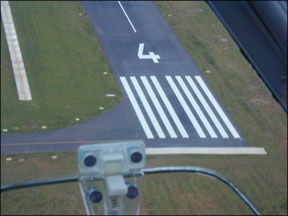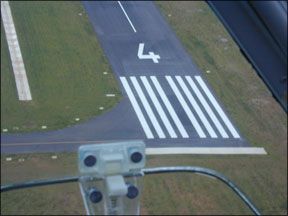Most airplanes spend the vast majority of their lives in straight and level flight; climbing, turning and descending only as necessary to get on and off a runway. Its when pilots start yanking and banking, however gently and smoothly their control inputs, that problems start to arise-and the accident rate starts to increase. And when the yanking and banking takes place close to the ground, any error margin becomes slimmer still. 288 In fact, according to the AOPA Air Safety Foundation (AOPA ASF) and its 2006 
Just what are “maneuvering” accidents, where do they occur, how do they occur and what can pilots of every stripe and experience level do to prevent them?
Defining The Problem
As far as the AOPA ASF is concerned, “When you operate in the traffic pattern, do aerial work or formation flying, or practice stalls and spins, you perform maneuvering flight.” The high number of accidents during these flight operations is almost enough to make us want to ask, “Why cant Johnny fly?” The answer is that Johnny can fly just fine; he just cant seem to make safe decisions on how and when to turn, how low is too low and when to keep up the speed. Take this pilot of a Cessna 152, for instance.
On February 21, 2002, near Blowing Rock, N.C., the 152 pilot and his passenger were injured when their airplane-one never accused of being overpowered-encountered a strong downdraft and was pushed into treetops. The wind didnt need to exert itself much since the airplane “was maneuvering 50 to 100 feet above trees in mountainous terrain,” according to the NTSB.
Reported weather conditions in the area included surface winds from 280 degrees at 24 knots, gusting to 37 knots, close to the 152s stall speed. The airplane came to rest southeast of and approximately 100 yards below a 2630-foot peak, about 3.5 miles east of a 3800-foot ridge.
In addition to this pilot deciding a flight close to trees was the right thing to do, he chose a day when the bumps generated by those gusty winds flowing over the terrain must have made the ride extremely uncomfortable. Sadly, our hapless 152 pilot is not alone in his desire to shave the maneuvering margin: The accident record is filled with details of accidents occurring after low-level flights.
Traditional “buzzing” takes its annual toll, also. Consider the June 23, 2005, crash of a Piper J3C Cub in Yadkinville, N.C. According to the NTSB, the airplane was “maneuvering low along Highway 601, buzzing a worker on a tractor.” During one pass, the airplane collided with transmission lines and the pilot apparently applied full power, pitching up dramatically, perhaps trying to climb away.
Instead, the power lines became entangled around the left wing; the airplane rolled inverted and hit the ground. After the accident, an examination of the airplane failed to find anything wrong with it before impact.
From these two accidents, we get the idea that poor decision-making is to blame for low-level maneuvering, and thats certainly a major part of the problem. As the ASFs
Nall Report drily put it, “Improving aeronautical decision making is one approach for reducing pilot-related accidents such as those that involve maneuvering.” But its not all.Reducing The Safety Margin
Anytime were airborne, were increasing the risks we deal with in our everyday lives. (If flying wasnt more risky and complicated than, say, sitting at home, anybody could do it and we wouldnt need a pilot certificate.) But some pilots in maneuvering accidents seem more than willing to reduce their safety margins thickness to that of a sheet of paper.
In another accident found in the NTSBs files, a pilot was-yet again-buzzing a friends house. This one occurred on June 6, 2004, near Decatur, Ala., in a Cessna 150. After beginning a descent from about 1500 feet msl, the pilot saw power lines, advanced the throttle and pulled back on the yoke to avoid them. Alas, the engine did not produce an immediate response. Instead, the airplane collided with the power lines at about 50 feet agl and the pilot made a forced landing in a nearby field.
Not having enough altitude to properly deal with a full or partial engine failure is a prime example of how the safety margin is reduced in low-level maneuvering. Presuming the 150s engine wouldnt have responded during some other flight operation, the low altitude, power lines and general lack of options “when something goes wrong” strongly argues against this kind of low-level maneuvering. By placing himself and his airplane at such a low altitude and in close proximity to obstacles, the pilot eliminated the safety margin normally available when theres some clear air underneath an airplanes wings.
Too Low For Recovery
But engine failures are not the only reason we should try to have some altitude when maneuvering. These accidents usually involve altitudes at which recovering from a stall or other example of poor skill and technique compounds a problem. In many cases, the problem wouldnt be a problem at all with more altitude.
One example involved the October 27, 2006, fatal crash of a Cirrus SR22 near Statesville, N.C. As the IFR flight neared its destination of Mooresville, N.C., the pilot elected to divert to a nearby facility with an instrument approach. After flying an ILS approach, witnesses observed the airplane come out of the clouds over the runway. Despite not being cleared for nor having the weather minima allowing a circle-to-land maneuver, the airplane was observed in a turn and re-entered clouds.
After more low-level maneuvering in and out of the clouds, the airplane was observed making a steep turn to the right and then back to the left. At this point, the nose of the airplane pitched down, and it collided with trees and the ground. The NTSB determined the pilot failed to maintain airspeed while maneuvering and stalled. While this accident is almost a poster-child example for poor decision making, recovering from the stall using either traditional technique or the airframe parachute required more altitude than was available.
Losing Focus
Many pilots guilty of starving their airplanes of fuel are heard to complain about one distraction or another preventing them from switching tanks or some other task-like buying gas before takeoff-required to ensure the engine kept running. When considering low-level maneuvering accidents, the same basic thing can happen.
For example, say youre out buzzing a family members house, waving to everyone who rushed outside to find out who is the lunatic in the airplane making all that noise. While youre-hopefully-paying close attention outside the airplane to things like trees, power lines, radio and television transmitters, and the house itself, how close were you to stalling on that last pass? (Hint: You wont always hear the warning when the airplane enters an accelerated stall.). Were you above, at or below the airplanes maneuvering speed when you executed that high-g pull-up on the last pass? Is the amount of fuel in the selected tank enough to prevent unporting -and ensure continuous fuel flow to the engine-when you rack your Aeronca over into that 90-degree bank?
Another risk is forgetting about the flagpole a family member just installed or the tall oak tree down the street (lets hope youre not flying
that low). Concentrating on a good “buzz job” to the exclusion of all else-losing ones focus on the many obstacles, real and figurative you may encounter-poses a real and greater risk during low-level maneuvering than many pilots realize.The bottom line is that low-level maneuvering requires a lot more attention and concentration from the pilot than just sitting in level cruise at a safe altitude. Theres more going on, to be sure, but many of the maneuvers you might be tempted to fly at such a low altitude require a finesse you may have lost, presuming you ever had it.
Breaking The Airplane
One of the too-sad, frustratingly inexplicable low-level maneuvering accident scenarios is exemplified by the recent crash of a Beech Model 58 Baron, one weve mentioned before. It involves the airplanes in-flight breakup on April 22, 2007, as the pilot was apparently performing aerobatic maneuvers.
According to a witness attracted to the apparent sound of an airplane performing some acrobatic maneuvers, the airplane was “high and descending very fast in a 45 to 60 degree, nose-down attitude.” The witness looked up just in time to see a wing or part of the tail separate from the airplane. That structural failure initiated a crash sequence that ended in a line of debris extending over 1100 feet. All five aboard the piston twin died.
During its investigation, the NTSB retrieved data from the Garmin 496 portable GPS navigator the pilot was using. According to the data, the airplane descended from 9470 feet to 8478 feet with a descent rate of some 3000 fpm, with the Barons groundspeed varying from 222 mph to 266 mph. From 8478 feet, the airplane-and its occupants-was on the ground less than 20 seconds later, according to NTSB data.
According to the NTSB, the pilot in this accident exemplified the “accident waiting to happen” concept. Shortly after this crash, a local law enforcement officer at the accident site was approached by a man who “stated that the accident pilots flying skills were below his standards because the pilot was known for overstressing the planes he flew. The motorist, having flown with the accident pilot previously, also indicated that he made a statement to a friend about three weeks ago that the accident pilot would probably crash an airplane within the next year.” Sadly, it didnt take nearly that long.
While this accident demonstrates how an airplane can come apart when used for maneuvers its designers never intended and its operating limitations are exceeded, the record firmly establishes this pilots anti-authority attitude. There was much more going on here than “just” low-level maneuvering.
Staying Out of The Weeds
The “classic” low-level maneuvering accident, then, probably doesnt have a single precipitating characteristic. An exception to this “rule,” however, involves the pilot who places or allows the airplane into a position from which an errant gust of wind, engine hesitation, failure to maintain airspeed or unseen obstacle can ruin his or her day. And, of course, theres the anti-authority attitude leading pilots to perform maneuvers-at any altitude-exceeding the airplanes limitations. In that scenario, all bets are off.
So, once again, the burden of avoiding maneuvering accidents-as is the case most of the time-falls squarely onto the pilots shoulders. There are a lot of ways to have fun in an airplane without placing you and your passengers in situations where a sudden gust of wind or slug of water in the fuel puts all of you in the weeds. An airplane is no place to be showing off for friends-demonstrate to them how unremarkable personal aviation can be, instead.
Sometimes-when landing and taking off, for example-we must maneuver at low altitudes. Planning for eventualities like where to put the plane when its engine fails on takeoff and ensuring a safe margin above stall speed, along with coordinated turns and early go-arounds, will further minimize for the skilled, prepared and conscientious pilot what is already a very small risk.
As with so many things in aviation, though, avoiding the maneuvering accident requires a healthy respect for what can happen when you eliminate existing safety margins.




